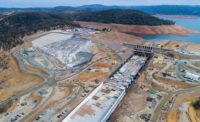Crews have nearly completed demolition of a buried nuclear-reactor caisson at Humboldt Bay Power Plant Unit 3. The milestone signals the final stages of the facility’s 35-year-long decommissioning saga.
Located just a few feet from the Pacific Ocean near Eureka, Calif., Unit 3 was the first commercial nuclear power plant to feature a below-grade reactor core.
Constructed in the late 1950s, the vessel was housed within a 60-ft-dia concrete caisson that was buried 80 ft underground and nearly 66 ft below sea level.
“We’ve been mining our way to the bottom, and we are very close now,” says John Gilbert, APTIM project manager.
Last year, the APTIM-led team (formerly Chicago Bridge & Iron) completed a 13-ft-thick, 110-ft-dia cutter soil mix (CSM) wall that encompassed the footprint of the caisson and surrounding soil to a depth of up to 172 ft. (ENR Calif., 5/30/16). The cylindrical barrier wall, which creates a watertight and seismically stable workspace for demolition to take place at the center, was formed in a complex, overlapping pattern of 255 separate castings within five concentric rings of varying depths. A custom-built drilling rig with an extended kelly bar enabled the team to reach what it calls “record-breaking depths” for this type of CSM wall.
Once the wall was complete, subcontractor Northwest Demolition & Dismantling began excavation in October 2016.
“The shoring system–water cutoff wall worked exactly as we had envisioned it,” Gilbert says. “There was a lot of concern out there because the size of this excavation using CSM technology had never been done to this level before. All in all, it’s performed extremely well. The rest of the nuclear industry has to take a close look at this technology for these deeper excavations and even for containment.”
To dismantle the core, crews first remove the soil surrounding the caisson to expose a 4 ft to 6 ft “island” of the concrete caisson at the center. The team follows “a process of excavating soil with a goal of maximining what is reusable, which isn’t as easy as it sounds because you are confined within a 110 foot diameter with three large pieces of equipment,” says Matthew Conley, project manager.
Next, technicians map radiological areas of concern, such as pipes or other penetrations, on the exposed caisson. Then, they break the concrete down to grade and again begin the excavation process with the next 4-ft to 6-ft section.
After workers remove and place the soil and other material on trucks, they scan each load using a Guardian array system to determine whether the material meets reuse criteria specified by the Nuclear Regulatory Commission.
The maximum depth of the hole will reach around 90 ft deep, depending on the depth of the caisson’s tremie pad. About 60% to 70% of the excavated soil will be reused on site as part of the 30,000 cu yd of backfill, Conley says. The contractor will pothole the top 10 ft of the CSM wall in several locations to re-equalize the high groundwater table in the area.
In addition to the CSM wall and caisson removal, APTIM’s contract includes demolition of approximately 65 structures, reclamation of the plant’s seawater intake and discharge canals, remediation of hazardous materials and full site restoration. The caisson demolition wraps up this month, with site restoration scheduled for completion in April 2018.
The $240-million project is running about $2 million under budget and two months ahead of schedule, Conley adds.
The plant operated from 1963 to 1976, when it was shut down for annual refueling and seismic modifications. In 1983, plant owner Pacific Gas & Electric Co. (PG&E) deemed the reactor too expensive to restart and began the decades-long SAFSTOR decommissioning process.






